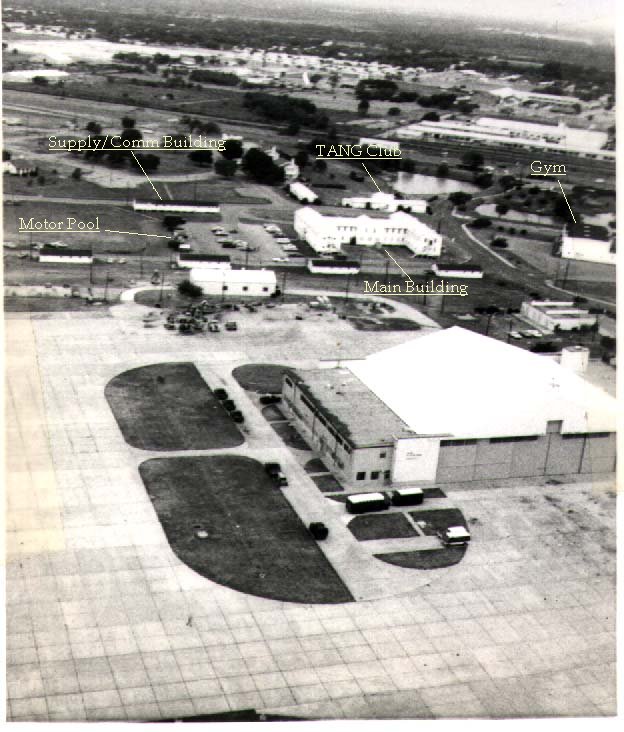A Brief History of the
Early Years of CRUSADER COMPOSITE SQUADRON
Page 3
Crusader Finds a Namesake -- a Navy Legend
Walden was keen to find his new squadron an identity -- a namesake, a mascot, something to rally around. I don't know who approached who, but somehow the squadron asked permission of Ling-Temco-Vought (LTV), the aerospace firm that manufactured the F-8 Crusader at its Dallas/Grand Prairie plant adjacent to NAS Dallas and Hensley Field (LTV and the military shared runways) to use the name "Crusader," and use the standard F-8 patch as the official squadron patch. They agreed. Along with the deal came a large supply of the cloth patches and soon they were adorning everyone's fatigues and flight suits.
Things took shape rapidly in 1970. Perhaps because of his Army background, Walden began molding Crusader into a serious mobile ground force. The objective was to build a deployable field capability of ground personnel that was completely self sustaining. That meant vehicles, shelter, electrical power, food, water, and extensive communications. Almost all our energies went into these areas. At the same time we were shaping our field capability, we also worked hard to establish a logistics support infrastructure at Hensley Field.
Walden noticed that there were several old unused buildings ringing the parking lot and field west of the building. These were all wooden, one-story, long, mostly open buildings each about thirty feet by seventy-five feet. Since the field sloped, these buildings were built on wooden piers to make them level. We were granted permission to use one, the building closest to the main building, which became the supply room and the communications room, or "comm shack." As was Walden's style, before we occupied the building, it got a fresh coat of paint inside and out, plus an extensive grooming of weeds, and overgrown bushes and sidewalks. The result was not "Better Homes and Gardens" material, but very respectable, crisp, neat, and orderly GI facilities.
The Viet Nam war was in full swing and there was a constant supply of "surplus" gear coming into NAS Dallas. Somehow, Walden made some good contacts, and soon we were receiving tons (literally) of uniforms, radio equipment, and field gear. The uniforms quickly filled up the supply portion of the first building, and brought about the requirement to take over the next section of the building, which also quickly filled. Many cadets spent many hours sorting all manner of uniform out from huge crates to size, count and organize into a genuine supply room. Much of the uniforms were unserviceable, but there were enough in the bunch to make it worthwhile. Items included fatigues, boots, shoes, hats, belts, 1505's (khakis) , service dress (back then called Class A's--and there were separate winter and summer weights for pants and jackets), flight suits, parkas, canteens, web belts, back packs, and other odds and ends.
The comm shack was outfitted with an odd array of surplus equipment that eventually included 26.620, VHF-FM, SSB-HF, air to ground, and other shortwave receivers and test equipment. Some of it was military gear and was there more for show of dials and big knobs than any useful CAP functionality. But it was truly impressive, especially to wide-eyed teenagers. One big event at the comm shack was the day we had the base civil engineers (or maybe the Seabees) plant an extra tall utility pole next to the shack. Lt Walt Hadler climbed the pole with the help of a base fire department ladder truck, to install antennas at the top. He was completely decked out with hard hat, spiked climbing boots, and safety harness. However, tragedy befell him, and he slipped, sliding down the pole. He was not critically injured, but he picked up some serious splinters on the way down that sent him to the hospital, and laid him up for a while.
Nonetheless, we got all the antennas up that day, plus some cables that connected the comm/supply building to the main squadron building. Walden installed a system of intercoms around the main building, and to the out buildings. He even put a loudspeaker on the utility pole. The whole thing was set up so that Walden could monitor any room, or the parking lot from his desk. He could then keep tabs on everyone, or blast announcements to those outside. It may be difficult to understand what all the attention to the outside was, until you learn the scope of what was going on outside. That will be covered in the next section.
In the future: We amass an armada of vehicles - convoy time!
Rebuilding a crashed L-16 -- LTV to the rescue
Building a reputation on Communications -- Eagle Nest 130
And more....

